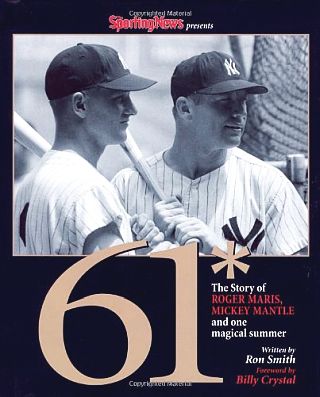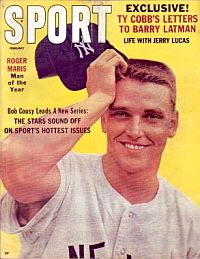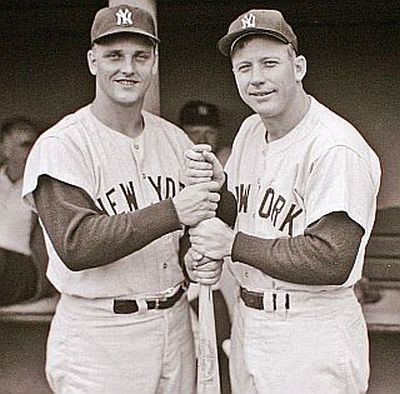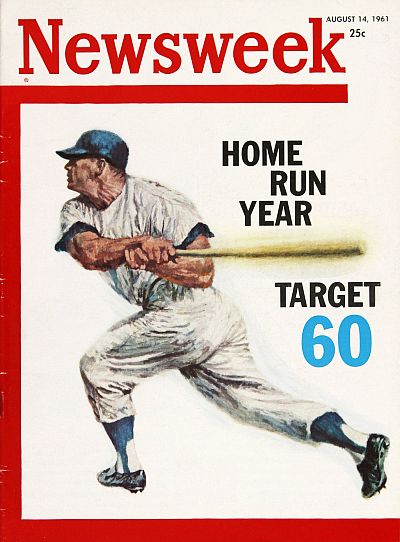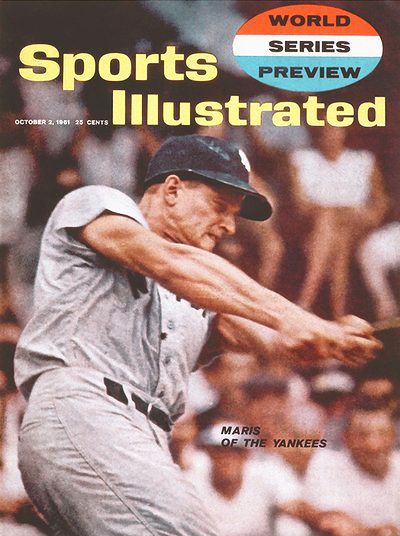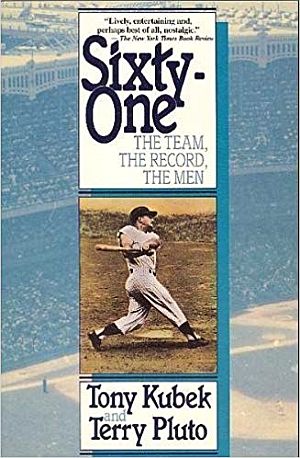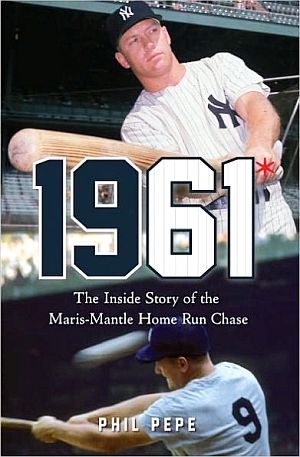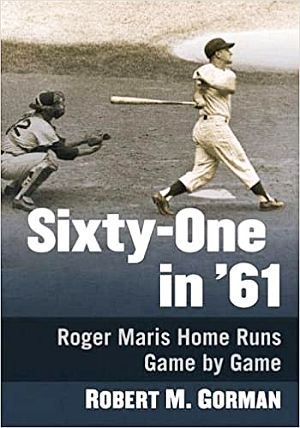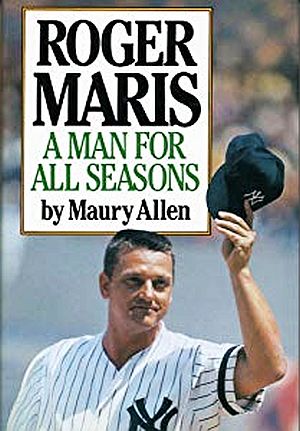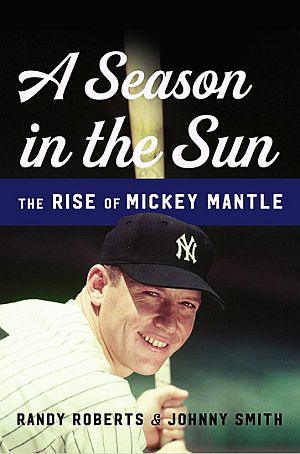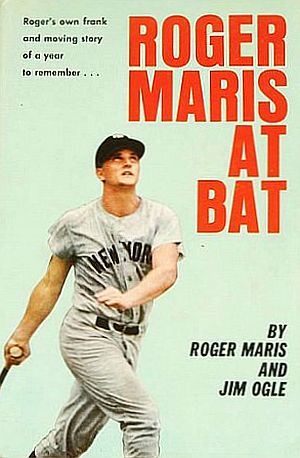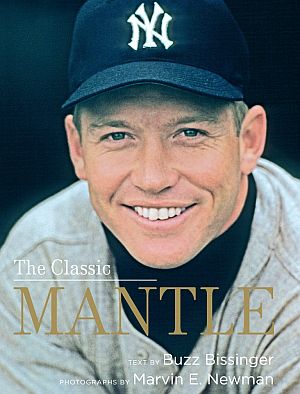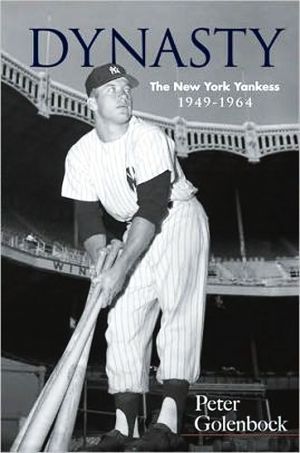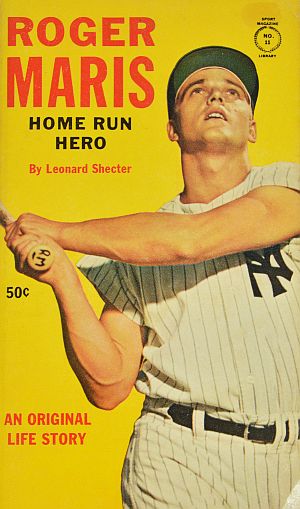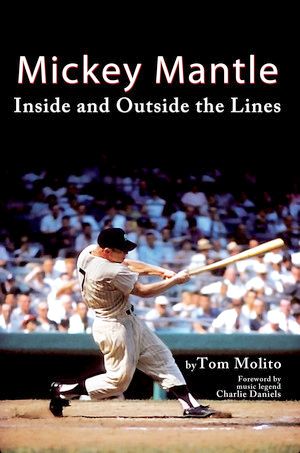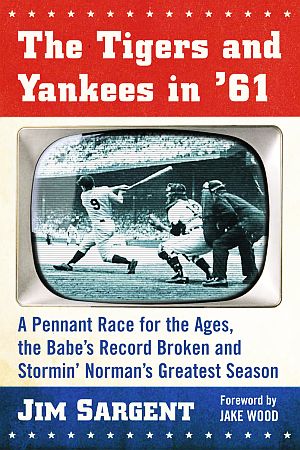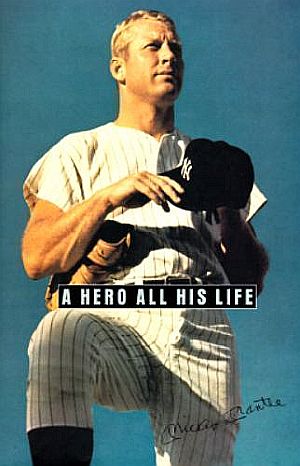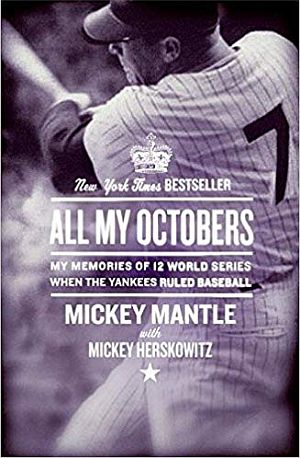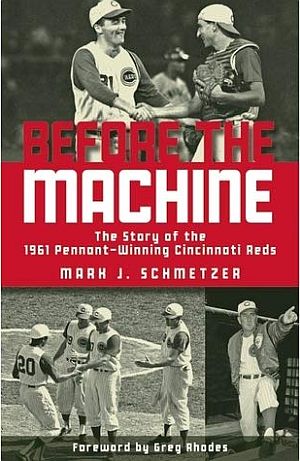The Mantle-Maris “race” in 1961 was about more than just who could hit the most home runs that year. Rather, it was also about which one of the two might be first to topple the venerable home run mark set by former Yankee, Babe Ruth in 1927. Ruth hit 60 home runs that year, and by 1961, his record had stood for 34 years.
Prior to 1961, only two other players had approached Ruth’s record: Jimmie Foxx of the Philadelphia Athletics in 1932 and Hank Greenberg of the Detroit Tigers in 1938, both of whom hit 58 home runs. Hack Wilson of the Chicago Cubs hit 56 in 1930, and Ralph Kiner of the Pittsburgh Pirates and Johnny Mize of the New York Giants hit 51 in 1947. Kiner also hit 54 in 1949. Willie Mays of the New York Giants hit 51 in 1955, and Mickey Mantle hit 52 in 1956. Still, in most years, the home run leaders were in the 40s.
The pursuit of Ruth’s record in 1961 by Mantle and Maris wasn’t something purposely stated by either man at the outset of the season, though they were asked about it frequently by the press. In their private thoughts, no doubt, each man wanted to break Ruth’s record. And as both Mantle and Maris had impressive home run totals in previous years, there was periodic press speculation about one or the other of them breaking Ruth’s record
Still, as the season began, no one was flatly predicting that either Maris or Mantle, or anyone else, would hit 61 home runs that year. And for Mantle and Maris, there was also the uncertainty that comes with any baseball season, each man’s abilities, the possibility of batting slumps or personal injury, other competitors outperforming them, etc. But as the season progressed, and the home run count for Mantle and Maris each rose, the race between “the M&M boys” as they came to be called, soon captivated baseball fans and the broader public, while permeating popular culture of that day and for years to come. What follows here is a review of that season, with photos, press accounts, and later, a timeline, as well as a postscript on events that followed the 1961 season, including a Hollywood film and the numerous books that came out on the pair and their home run race. But first, some background on Maris and Mantle.

Late 1950s. Roger Maris with the Cleveland Indians.
Roger Maris
Roger Maris grew up in Fargo. N.D and was an outstanding athlete at Shanley High School, an all-state halfback in football, who led the state in scoring his senior year and helped Shanley win the North Dakota championship as a junior. He also set a record for returning 4 consecutive kickoffs in one game.
In addition to football, Maris was also a standout in basketball and track. Shanley, like other high schools in the state, did not play spring baseball because of the long North Dakota winters. However, Maris did play summer baseball as a boy, and also at the American Legion level, where he excelled.
But Roger Maris was first sought out for his football prowess, recruited by a number of colleges, including the legendary Bud Wilkinson of the University of Oklahoma, where Maris agreed to go. However, a baseball scout for the Cleveland Indians began waving around a $15,000 contract and signing bonus, and that appeared more enticing to Maris than college.
After four seasons in the minors Maris made his major league debut at in 1957 with the Indians, batting .235 with 14 homers and 51 RBI in 116 games. A year later he was traded to Kansas City, and from there, to the Yankees. In New York, however, he would soon prove his worth.
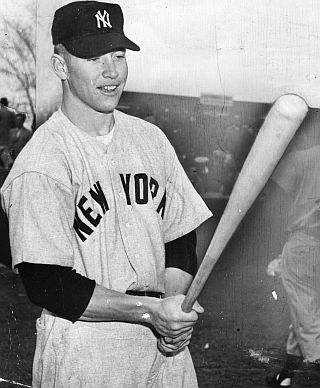
March 1951: Young Mickey Mantle picking out a bat at New York Yankee spring training.
Mickey Mantle
Mickey Mantle had been with the Yankees nearly a decade when Roger Maris arrived. Mantle had come to the Yankees in 1951 as a 19 year-old sensation from Oklahoma – a player with a rare combination of speed and switch-hitting power the game had not seen in years.
Like Maris, Mantle had played running back as a high school football player, but baseball was his passion, instilled by his father who had worked with him as a young boy, insisting he become a switch hitter.
As a muscular, 5′-11,’ 195-pound baseball player, Mickey Mantle packed amazing power into his swings, and during his career would hit some memorable 500-foot-plus home run shots. He could also move with lightening speed running the bases and in the outfield, especially in his early years.
In his early spring training appearances with the Yankees in 1951, he had received effusive praise from famous Yankees such as former catcher and Hall of Famer, Bill Dickey, then a Yankee coach. Dickey, not prone to exaggeration, would say of the young Mantle: “I thought when I was playing with Ruth and Gehrig I was seeing all I was ever gonna see. But this kid [Mantle]… Ruth and Gehrig had power, but I’ve seen Mickey hit seven balls, seven so far…. Well, I’ve never seen nothing like it.”

Mickey Mantle on the cover of Sports Illustrated in June 1956, the year he would win Triple Crown batting honors.
When Mantle came to play with the Yankees, he was touted as the next link in the legendary line of Yankee superstars, and the likely replacement for Joe DiMaggio, whose centerfield spot he would inherit full time in 1952.
Although the young Mantle had a rough start with the Yankees in the early 1950s, sent for a short stint in the Yankee farm system, and disappointing fans when he didn’t become an instant DiMaggio or Ruth, he soon began demonstrating his superstar talents.
By the time Roger Maris arrived in 1960, Mantle’s heroics had already put him on the covers of Time, Life, and Sports Illustrated magazines, and often in the headlines of the New York sports pages. In 1956, Mantle posted a .353 batting average, slammed 52 homers, and drove in 130 runs, winning the Triple Crown, a rare baseball achievement. At that time, in fact, he was only the twelfth player in baseball history to have won it. And to date, Mantle is the last Triple Crown winner to have led all of Major League Baseball in all three Triple Crown categories.
1960, Early 1961
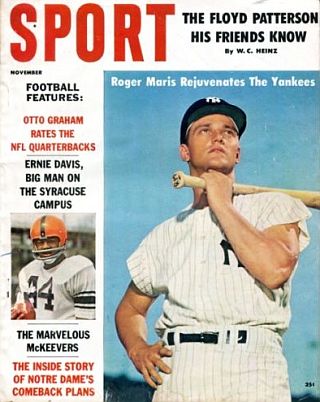
Nov. 1960: Roger Maris featured in ‘Sport’ magazine cover story: “Roger Maris Rejuvenates The Yankees’.
Although the Yankees had won the pennant in 1960, and were favored to beat the Pittsburgh Pirates in the World Series, the Pirates prevailed, wining one of the most dramatic Game 7 battles in baseball history.
By November 1960, Sport magazine featured Maris in a cover story touting him as rejuvenating the Yankees. Still, compared to Mantle, Maris was the newcomer and slow to become a fan favorite. But at the beginning of 1961 at least, Maris appeared to have no designs on Ruth’s record, and was asked by an Associated Press reporter if the expanded 164 game schedule that year might make it possible to break Ruth’s record. His reply: “Nobody will touch it… Look up the records and you’ll see that it’s a rare year when anybody hits 50 homers, let alone 60.”
In mid-January 1961, Mickey Mantle, then 29, was the highest-paid active player in professional baseball. That year he signed a $75,000 contract with the Yankees (equal to more than $620,000 in 2018, but still a pittance compared to what elite players now get under free agency). Heading into the baseball season that year, Mantle said: “I don’t remember when I have felt better at this stage. I ought to have my best year.” In the previous year, he noted he had hit .275 and “struck out much too much” (125 times). For the coming 1961 season, he said: “I’m setting my sights on a .300 plus batting average, 100 runs batted in and at least 40 home runs. And I’m not going to strike out as often.” Mantle’s lifetime batting average at that point, after 10 years with the Yankees, was over .300.
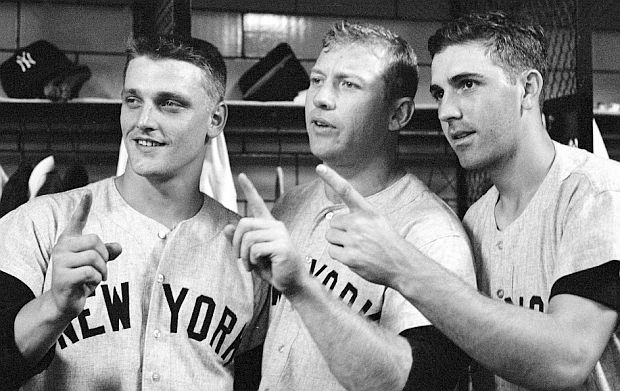
October 12th, 1960, Forbes Field, Pittsburgh, PA. New York Yankees Roger Maris, Mickey Mantle, and Clete Boyer are optimistic about their chances in winning the 1960 World Series against the Pittsburgh Pirates, having just thrashed the Pirates in Game 6 by a 12-0 score. "1 more" is all they need, say the boys, but it was not to be, as the Pirates pulled off one of the most exciting World Series finishes in baseball history. Click for separate story.
In the 1960 World Series against Pittsburgh, Mantle hit a torrid .400, going 10 for 25 with 1 double, 3 homers, 8 runs scored, and 11 RBIs. Roger Maris hit .267 in the series, contributing 8 hits including a double, 2 home runs, and 6 runs scored.
In March 1961, during Mantle’s first spring training season under new Yankee manager Ralph Houk, Mantle blasted a towering home run shot against the Dodgers at their Dodgertown stadium in Vero Beach, Florida. That Mantle drive soared over the right field fence and went completely out of the park, disappearing into the distance. It was a good omen for the home run derby to come between he and Maris in the regular season.
In addition to Maris and Mantle, the Yankees in 1961 were loaded with talent, and any number of guys who could hit the long ball – including Yogi Berra, Elston Howard, Clete Boyer, Moose Skowron, and John Blanchard. On the mound was ace Whitey Ford, and a superb reliever in Luis Arroyo. So coming into the 1961 season, the Yankees were favored to win the American League pennant.

1961. Roger Maris watching one of his home runs take flight.
The M&M Race
In the home run race between Mantle and Maris that season, the lead would shift back and forth between the two power hitters numerous times throughout the summer.
Mantle got off to a strong start in April, hitting seven round trippers. Maris was slow at the start. The Yankees were already 11 games into the 1961 season before Maris hit his first home run. Mantle had a productive April, but Maris picked up the pace in May, hitting 11.
Nor were Mantle and Maris the only American Leaguers hitting home runs that season. By the end of May, Mantle led the American League with 14 home runs, with Jim Gentile of Baltimore next at 13, while Maris with 12 was tied for third place with Rocky Colovito of Detroit and Harmon Killibrew of Minnesota. These power hitters were also in the home run hunt through much of the summer, until both Maris and Mantle pulled away from the pack in later months.
In June, Maris hit 15 and Mantle 11.Still, they would each sometimes have four- and -five-game droughts without hitting a single home run, followed by a hot streak by one or the other, sometimes with multiple home runs in the same game. In Yankee Stadium on June 11th, Mantle hit an impressive upper deck home run against the Los Angeles Angels in the first inning of a second game doubleheader, giving Mantle the home run lead at 18 – but only momentarily. Two innings later, in the same game, Maris hit his 19th home run, followed by another in the seventh inning, raising his total to 20. During a 16-game road tour that month, Maris would hit seven more.
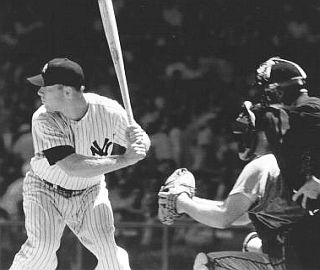
1961: Mickey Mantle, coiled up and waiting to strike.
“…I hope you believe me when I say I never give Babe Ruth a thought… I do not think about his record. I’m just surprised I’m able to hit this many. Thankful, too.”
Still, as the competition heated up between the M&M boys, the buzz among fans and press was increasingly about one or both of them breaking Ruth’s record. At the first All-Star game break of July 10-12 (there were two All-Star games played at the time, the second coming in August), Maris was in the lead at 33 home runs with Mantle at 29.
Then on July 17th that summer, Commissioner of Baseball, Ford Frick, made a ruling addressing the difference between the Ruth-era 154 game schedule and new 162 game schedule inaugurated that year in the American League to accommodate its expansion to 10 teams. Frick ruled that any home run total surpassing Ruth’s 60 would have to be accomplished in 154 games as Ruth did in order to be the official record. Failing that, and anyone hitting more than 60 during the 162 game schedule would have to carry some special mark or notation indicating that it was done during the longer schedule.

Roger Maris was a bit misunderstood by the press, who treated him unfairly in their reporting, adding to his woes and the pressure to beat the Ruth record.
In addition to the Frick ruling, Mantle and Maris were also fighting against history and some powerfully entrenched nostalgia – with Ruth’s widow, Claire Ruth, and several Hall of Famers, including Rogers Hornsby, and even some members of the Yankee organization, openly rooting against both of them. Numerous Yankee baseball fans, as well, did not want to see Ruth’s record upended.
But Mickey Mantle by then, who had suffered years of fans jeering him as a “hayseed” and pretender to the Yankee slugger throne, was now getting more sympathetic fan support.
“If anyone should break Ruth’s record,” went the new fan logic, “it should be Mantle.”
Maris was considered the outsider; not a true Yankee. And unlike Mantle, he was not the easy-going type, personality-wise. His workman-like focus on his craft was often mistaken for a dower, unconcerned disposition. And accordingly, he suffered, unfairly, for how the press portrayed him in their stories.
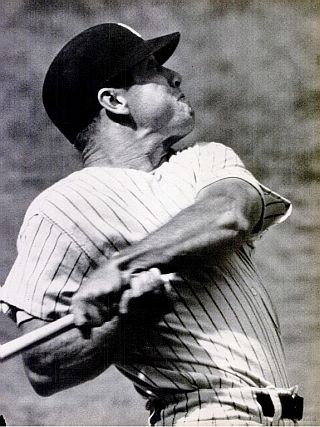
Mickey Mantle’s explosive power captured in photo as he hits one into the seats during the 1961 home run race.
Meanwhile, back in the home run hunt, Mickey Mantle went on a bit of tear in mid-July 1961, hitting seven homers in eight games at Yankee Stadium.
Against Chicago on July 13th and 14th, Mantle hit two (Nos. 30, and 31); on July 15 and 16 in games against Baltimore, he hit Nos. 32 and 33; and against Washington on July 18th he hit Nos. 34 and 35 in the same game, and No. 36 on the following day, also against Washington. Maris was then having a bit of a hitless stretch over some 19 at-bats in six games.
But Maris soon broke out of his funk in a big way on July 25th in Boston. During a doubleheader there he hit four home runs – two in each game – for Nos. 37, 38, 39 & 40. Mantle hit No. 37 during the first game of that doubleheader. At this point, the M&M boys were running about 20 games ahead of Ruth’s 1927 pace.
Others in the American League were also on the home run leader board, though somewhat behind Mantle and Maris – Harmon Killebrew at 30, and Rocky Colavito, Norm Cash, and Jim Gentile, all tied with 27.
In early August, Mantle had another multiple home run performance, hitting three home runs – Nos. 41, 42, and 43 – during an August 6th doubleheader with Minnesota before 39,408 fans at Yankee Stadium. Maris had hit his 41st homer two days earlier.
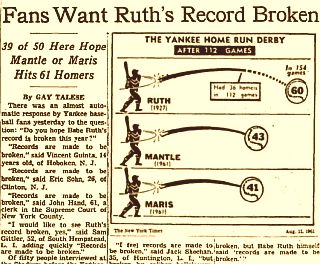
Aug 11, 1961: NYTimes finds fan support for breaking Ruth’s record & begins publishing comparative home run chart.
That story also included a chart comparing where each Ruth, Mantle and Maris were in their progression of hitting home runs after 112 games: Ruth 36, Maris 41, and Mantle 43. The New York Times would continue running that graphic – titled “The Yankee Home Run Derby” – on the sports page in subsequent Times reporting, updated with each new Mantle or Maris addition.
On August 11, Mantle hit his 44 and Maris his 42 in Washington, D.C. game against the Senators, as the Yankees had won nine in a row. The Yankee win streak ended the next day, as they lost to the Senators, but Maris hit his 43rd. By August 13th, with Maris homering twice and Mantle once during a doubleheader with the Senators, the Yankee duo were then tied at 45 home runs a piece and still ahead of Ruth’s pace.

August 18, 1961. Life magazine, then one of the premiere news and lifestyle sources of its day, runs a featured cover story on the Mantle and Maris race to upend Ruth’s record. Click for copy.
The Mantle-Maris cover photo was taken by photographer Philippe Halsman, while the ghostly background photo of Ruth from earlier times had been taken by William Greene. Inside the magazine, a several-page story featured Mantle and Maris in separate photos, each swinging mightily for the fences.
Life titled its story “Math Muscles in On The Race Against Ruth,” in which it explored the use of “Bernoullis Distribution,” a mathematical formula used to project probability. Life even offered charts and graphs in the application of the formula to the chances of Mantle and/or Maris breaking Ruth’s record.
Life concluded: “Based on this season performance after 110 games… Mantle’s chances were 50-50. The odds were 4-1 against Maris, but the combined probability of one or the other or both men breaking the record was 3-2 in favor.”
Still, with more than 40 games to go in that chase, Life acknowledged there were certain other variables and imponderables that could still come into play for Mantle and Maris. And in Ruth’s case in 1927, the formula was no predictor whatsoever. In any case, the Life magazine story was one more indicator as how the nation had fastened its attention on the M&M boys. But behind the scenes, there was a high-stakes drama in play as well, and it was taking a toll on both hitters, especially Maris.
Mickey Mantle and Roger Maris were much alike on one level, both coming from the Midwest, raised in working class families, with similar high school athletic stardom, and both marrying their high school sweethearts. Yet, in terms of personality and lifestyle, they were quite different. Mantle was more outgoing and gregarious than Maris, and liked being in the limelight. Though he played it humbly, Mantle really loved the media attention and he wanted the adulation. Maris only wanted to play baseball; he didn’t want the celebrity that might come with breaking Ruth’s record, and he especially did not want the press attention that hounded him that summer.
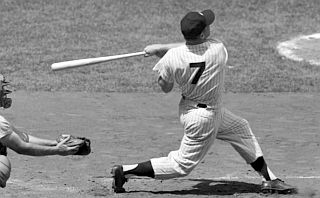 Mickey Mantle, a switch-hitter, showing his power from the right side of the plate, capable of 'distant shot' home runs of 500 feet or more. |
 Roger Maris was a line-drive power hitter with a long, smooth swing, and more of a contact hitter. |
Press Pressure
Mantle had the benefit of 10 years experience in the New York fishbowl, and had learned quickly how and when to smile and what to say and not say to the press. Still, Mantle had had his bad times with fans and press, and earlier had been given “the hick treatment,” also receiving his share of grandstand booing and bad press when he didn’t perform, sometimes regarded as a DiMaggio upstart.
Even in 1956, on his way to the Triple Crown, as Mantle crossed the 50 home run threshold and was seen as a possible contender to the Ruth home run record, fans and press jumped on him as the undeserving soul and threat to the Ruth legacy.
Now, Maris was getting the treatment full bore – fans jeering and booing him, receiving threatening mail and telegrams, and followed by a constant throng of press at his every turn. He wasn’t prepared for it, and had little help dealing with it. And he often made matters worse by his statements or behavior, or stubbornly sticking to his course with an “I’ll-show-them” determination. Yet this attitude often made the press go after him all the more. In his book, October 1964, David Halberstam would write of Maris in the latter months of the 1961 home run race:
…The more he [Maris] became the story, the warier he became. The Yankees, completely unprepared for the media circus, gave him no help, offered him no protection, and set not guidelines. They let him, stubborn, suspicious and without guile, hang out there alone, utterly ill prepared for this ordeal; they never gave him a press officer to serve as a buffer between him and the media, or even set certain times when he would deal with the reporters, so what it would not be a constant burden. They did not filter requests, or tell him who he might trust and whom he might not or which requests were legitimate and which were trivial.
Under all this pressure, Maris grew more and more irritable. He found that he could go nowhere without a phalanx of journalists….
Some of the media had also fabricated a rivalry between Maris and Mantle that didn’t exist. That was obviously good for selling newspapers and gaining TV share, but it wasn’t true. Mantle and Maris, along with Bob Cerv, a Yankee friend of Maris’s, lived together in a Queens apartment for most of the 1961 season. Maris and Cerv had in effect, rescued Mantle from his more freewheeling lifestyle and Times Square hangovers, when he lived downtown at the St. Moritz hotel. Sure, Mantle and Maris were competitors in the home run race, but they were also friends despite significant lifestyle differences. And as a pair of New York Yankees hitting home runs, they were very good for the business of baseball, and not only in New York.
As the Yankees went on the road to other cities, record crowds began coming out, but not to see their home teams. “Cleveland baseball fans,” wrote the New York Times’ John Drebinger in a story filed from Cleveland on August 18th, “who soured on the Indians weeks and weeks ago, turned out 37,840 strong tonight – the largest crowd of the local season – to see the Yankee bombers, heated by Roger Maris and Mickey Mantle, do their stuff.”

August 21, 1961 New York Times story on the increased interest of TV viewers tuning in for the home run race.
The New York Times of August 21, 1961 ran a story headlined “TV: Battle of the Bats – Home Run Hitting of Maris and Mantle Increases Interest in Yankee Telecasts.” The TV baseball audience, it seemed, had suddenly swelled to World Series levels six weeks early, all to watch the exploits of Maris and Mantle. Some New Yorkers were even foregoing visits to the beach in favor of watching the Yankees on TV. “In office building, bars and other locations,” wrote Times reporter John Shanley, “the cluster of fans around TV sets testify to the extraordinary interest” in the Maris-Mantle home run duel. Radio audiences for Yankee games were also up.
Roger Maris, in particular, continued his hot-hitting through August, as Mantle went cold for a time. Maris became the first player in history to hit 50 home runs by the end of August. On August 26, in a game on the road against Kansas City, Maris hit s 51st. But when the boys went hitless, as they did on August 27th, the headlines would note that too. On August 30th and 31st, Mantle got back on track, hitting home runs Nos. 47 and 48 in back-to-back games at Minnesota. For the month of August, Maris had hit 11 and Mantle 9.
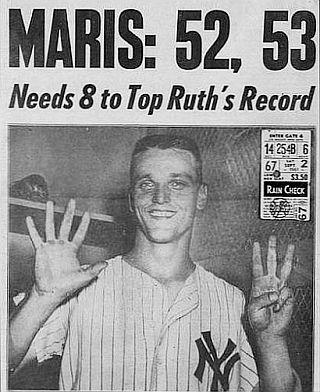
Sept 3, 1961 New York newspaper story with Roger Maris holding up a “5” and “3” hand count of the 8 more home runs needed to break Ruth's record (inset ticket stub incidental, not part of original story).
Both Maris and Mantle went hitless in the first game of the Detroit series, each going 0-for-4.
Then, on September 2nd, 1961 against the Tigers, before a Yankee Stadium crown of 50,261, Maris hit two home runs – Nos. 52 and 53. That made him the first Yankee to hit 53 in a season, after Ruth.
New York newspapers’ sports pages gave Maris top billing, crowing about his hitting, one showing a classic black and white photo of a smiling Maris holding up a hand count of “5” and “3” with the huge headline, “Maris: 52, 53; Needs 8 to Top Ruth’s Record.”
The following day against Detroit, on September 3rd, Mickey Mantle rejoined the home run race in a big way, hitting his Nos. 49 and 50 (see photo below). Mantle, in fact, wasn’t expected to play that game, as he had strained his left forearm muscle, and could be seen wincing in some photos of his swings that evening. But he kept playing.
And when the Washington Senators came to Yankee stadium on September 5th, Mantle hit No. 51. The following day against the Senators, Maris added his 54th. Then the Cleveland Indians came to Yankee Stadium for a four-game series, September 7th-thru-September 10th, during which Mantle hit Nos. 52 and 53, and Maris, Nos. 55 and 56. At this point, the combined total of home runs hit by Maris and Mantle, 109, eclipsed the previous record set by a pair of teammates — Ruth (60) and Gehrig (47) at 107 –set back in 1927.
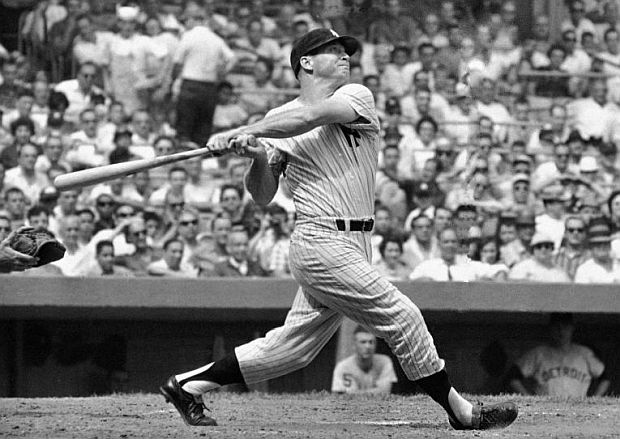
Mickey Mantle’s powerful swing from the left side of the plate, September 3, 1961, hitting his 49th home run during 1st inning against the Detroit Tigers at Yankee Stadium with Roger Maris aboard. Mantle would hit his 50th home run in the same game in the 9th inning. AP photo.
On September 14th, after the Yankees had dropped a doubleheader to the Chicago White Sox in Chicago, Mickey Mantle, who had gone hitless in both games, made a surprising statement after the game. “I can’t make it,” he said referring to the Ruth home run mark, “not even in 162 games. I figure if I could have hit a couple here (in the Chicago doubleheader) I might have been able to do it. But I don’t think I can do it now.” But there was more going on with Mantle at that time then he allowed in his remarks.
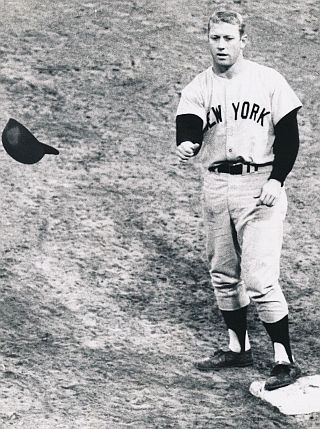
14 Sept `61. Mickey Mantle, frustrated at first base after grounding into a force play during Chicago game, afterwhich he would assess his HR record chances as poor, but he then had an infected hip.
Also in that series, Mantle had some heated words for Detroit pitching ace, Jim Bunning, who had thrown hard and inside to Mantle during one at bat, causing Mantle’s ire to rise – in part, no doubt, from his feeling ill and his home run frustration. At the time Mantle hadn’t hit a home run since September 10th, and was stuck at No. 53, while Maris had 57. The game itself would go into extra innings, until the top of the 12th when Maris hit his 58th homer of the season – a two-run blast – giving the Yanks a 6-4 victory. Maris would have three RBIs that day while Mantle struggled, going hitless in four at bats.
By the time the Yankees traveled to Baltimore for a three-game series, September 19-thru-21, Mantle only made one appearance as a pinch hitter. At the Yankees’ next stop in Boston on September 24th, Mantle made a surprise start and also hit his 54th home run – a three-run, first inning blast that helped the Yankees win that game. The next day in Boston, Mantle went hitless, and the day after that he could only play one inning. On the plane ride back from Boston, Mantle, still feeling under the weather, spoke with Yankee announcer Mel Allen who said he knew a doctor who could fix him up — an infamous physician, it turns out, named Max Jacobson. Dr. Jacobson, popular for a time with celebrities and even President John F. Kennedy, was known by the nickname, “Dr. Feelgood” for his rejuvenating injections of amphetamines (and who later had his medical license revoked). Mantle received one of Dr. Jacobson’s shots, ostensibly to knock out the virus, but the needle had hit Mantle’s hip bone, causing an abscess on his side that would later have to be lanced and drained. By September 28th, Mantle was taken to the hospital where he was treated for an infected hip, as doctors excised and packed the abscess. Mantle was effectively knocked out of the home run race, hospitalized for the final week of the season.
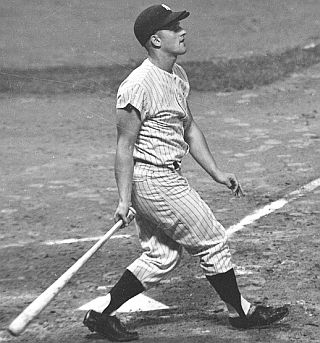
Roger Maris, watching one of his homers leave the yard.
The Yankees traveled next to Baltimore, Babe Ruth’s hometown to play the Orioles. There, Maris had some rough at bats in the first game of a doubleheader on September 19th. The second game was the 154th game of the season, in which he could equal or exceed Ruth. But there would be no Roger Maris home runs in that game either. On the next day at Baltimore, however, Maris hit No. 59. And with that day’s performance, Maris had once again moved into rarefied home run territory – now only the second player in major league history to hit 59 home runs, that also set by Ruth in 1921, six years before he hit 60.
Then there were two games on the road at Boston, September 23rd and 24th, where Maris did not hit another home run, but where Mantle had hit his last home run (No. 54) on the 23rd. The final five games of the 1961 season were played at home — two with Baltimore on September 26th and 27th, and three with Boston, September 29th & 30th and October 1st. In the first game with Baltimore on September 26th, Maris hit his 60th home run in the third inning. And then, in the final game of the 1961 season, on October 1st in the fourth inning, Roger Maris went into the record books with his 61st home run of the season, surpassing Babe Ruth.
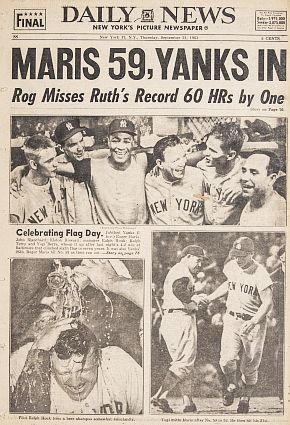 September 20, 1961, New York Daily News headlines and photos feature the 59th home run of Roger Maris (Yogi Berra greeting him at the plate) and the New York Yankees celebrating their 1961 American League pennant victory. |
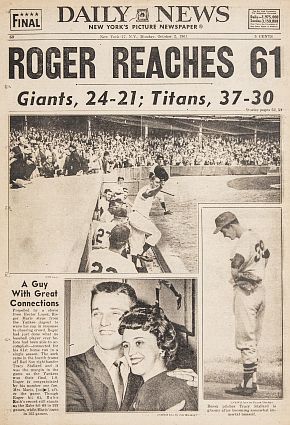 October 2, 1961, New York Daily News headlines and photos show Roger Maris coming out of the dugout to tip his hat to Yankee Stadium fans after hitting his 1961 season record 61st home run. Maris is also shown with his wife Pat. |
Rare Baseball Event
Exceptional Season
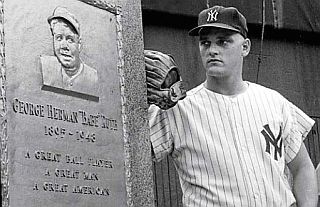
1961. Roger Maris, haunted by Babe Ruth all year, shown at the Babe's monument, then behind Yankee Stadium's center field.
Mickey Mantle played in 153 games that year, and his 1961 statistics included: 514 at bats, 163 hits, 54 home runs, 128 RBIs, 131 runs scored, 126 walks, 112 strike outs, an on-base percentage of.448, a slugging average of.687, and a batting average of .317, fourth best in the American League.
Roger Maris played in 161 games with 590 at bats, 159 hits, 61 home runs, 142 runs batted in, 132 runs scored, 94 walks, 67 strikeouts, an on base percentage of.372, a slugging average of.620, and a batting average of .269. He led the American League that year in runs scored, RBIs, and home runs.
The Yankees won the World Series that year, besting the Cincinnati Reds, 4 games to 1, but neither Mantle or Maris played major roles. Mantle, still recovering from his infected hip, made a few appearances in two of the games with one hit. Maris played all five games, went 4 for 19, with a home run and double, scoring 4 runs.Roger Maris won the 1961 American League MVP Award for the second consecutive year, with Mantle finishing second in the voting. As of this writing, Mantle and Maris still hold the single-season record for combined home runs by a pair of teammates at 115 (although as of 2018, current Yankee teammates Aaron Judge and Giancarlo Stanton may one day challenge that record).
Maris also collected a number of other awards following his 61 home run season. He won the Hickok Belt as the best professional athlete of the year. He was also voted Sport magazine’s Man of the Year (shown at left on February 1962 cover), The Sporting News Player of the Year, the Associated Press Male Athlete of the Year; and Sports Illustrated‘s Sportsman of the Year.
As for Maris-Ruth home run comparisons, some baseball historians note that it took Ruth 689 plate appearances (i.e., all at bats) to hit 60 home runs, while Maris hit his 60th after 684 plate appearances.
1961 Home Run Race
Mickey Mantle & Roger Maris
Day-By-Day Scorecard
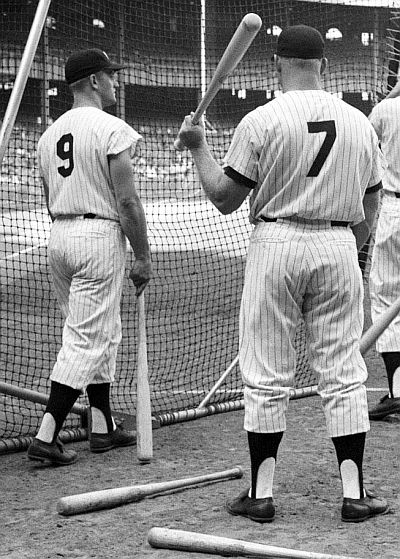 Prior year, August 1960: Roger Maris and Mickey Mantle await their turn at batting practice before a game at Yankee Stadium. In 1960, Maris hit 39 home runs (HRs) and Mantle 40. Photo, Neil Leifer, Sports Illustrated. |
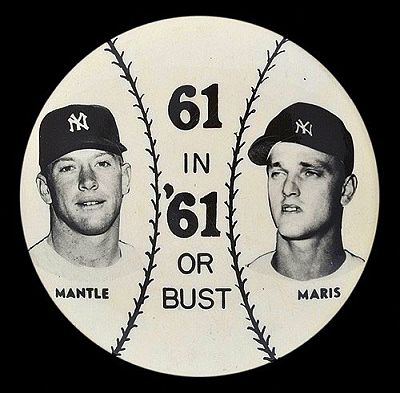 A pinback button – “61 in ‘61 or Bust” – among the fan paraphernalia that emerged during the Mickey Mantle-Roger Maris home run race of the summer of 1961. |
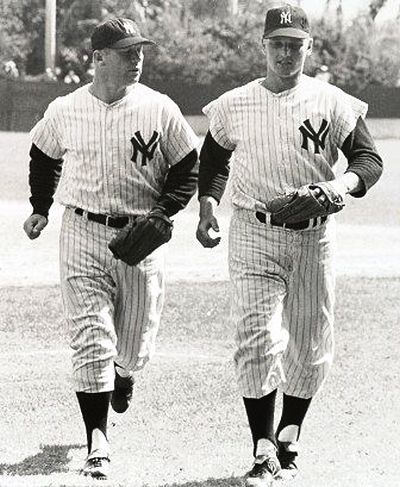 Mickey Mantle and Roger Maris jogging in from the outfield, circa 1960s. Mantle played center field, Maris played right field. |
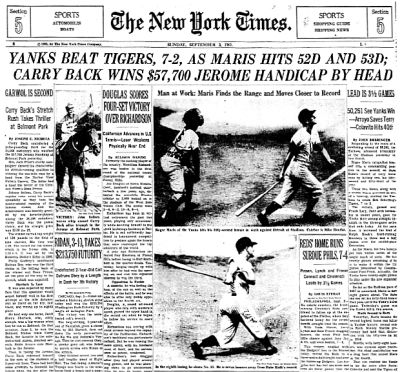 September 3rd, 1961 front page of the New York Times reporting on 52nd and 53rd home runs of Roger Maris at Yankee Stadium, with two photos. |
vs = home game
at = away game
April 1961
(Mantle 7, Maris 1)
17 April / vs. Kansas City
Mantle, #1
20 April / vs. Los Angeles
Mantle, #2 & #3
21 April / vs. Baltimore
Mantle, #4
23 April / vs. Baltimore
Mantle, #5
26 April / at Detroit
Maris, #1
26 April / at Detroit
Mantle #6 & #7
May 1961
(Mantle 7, Maris 11)
2 May / at Minnesota
Mantle, #8
3 May / at Minnesota
Maris, #2
4 May / at Minnesota
Mantle, #9
6 May / at Los Angeles
Maris, #3
16 May / vs Washington
Mantle, #10
17 May / vs Washington
Maris, #4
19 May / at Cleveland
Maris, #5
20 May / at Cleveland
Maris, #6
21 May, vs. Baltimore
Maris, #7
24 May, vs. Boston
Maris, #8
28 May, vs. Chicago
Maris, #9
29 May, at Boston
Mantle, #11
30 May, at Boston
Mantle, #12 & 13
30 May, at Boston
Maris, #10 & #11
31 May, at Boston
Maris, #12
31 May, at Boston
Mantle, #14
June 1961
(Mantle 11, Maris 15)
2 June, at Chicago
Maris, #13
3 June, at Chicago
Maris, #14
4 June, at Chicago
Maris, #15
5 June, vs. Minnesota
Mantle, #15
6 June, vs. Minnesota
Maris, #16
7 June, vs. Minnesota
Maris, #17
9 June, vs. Kansas City
Mantle, #16
9 June, vs. Kansas City
Maris, #18
10 June, vs. Kansas City
Mantle, #17
11 June, vs. Los Angeles
Mantle, #18
11 June, vs. Los Angeles
Maris, #19 & #20
13 June, at Cleveland
Maris, #21
14 June, at Cleveland
Maris, #22
15 June, at Cleveland
Mantle, #19
17 June, at Detroit
Maris, #23
17 June, at Detroit
Mantle, #20
18 June, at Detroit
Maris, #24
19 June, at Kansas City
Maris, #25
20 June, at Kansas City
Maris, #26
21 June, at Kansas City
Mantle, #21
22 June, at Kansas City
Mantle, #22
22 June, at Kansas City
Maris, #27
26 June, at Los Angeles
Mantle, #23
28 June, at Los Angeles
Mantle, #24
30 June, vs,Washington
Mantle, #25
July 1961
(Mantle 14, Maris 13)
1 July, vs. Washington
Mantle, #26 & #27
1 July, vs. Washington
Maris, #28
2 July, vs. Washington
Maris, #29 & #30
2 July, vs. Washington
Mantle, #28
4 July, vs. Detroit
Maris, #31
5 July, vs. Cleveland
Maris, #32
8 July, vs. Boston
Mantle, #29
9 July, vs. Boston
Maris, #33
13 July, vs. Chicago
Maris, #34
13 July, vs. Chicago
Mantle, #30
14 July, vs. Chicago
Mantle, #31
15 July, vs. Chicago
Maris, #35
16 July, vs. Baltimore
Mantle, #32
17 July, vs. Baltimore
Mantle, #33
18 July, vs. Washington
Mantle, #34 & #35
19 July, vs. Washington
Mantle, #36
21 July, at Boston
Maris, #36
21 July, at Boston
Mantle, #37
25 July, vs. Chicago
Maris, #37
25 July, vs. Chicago
Mantle, #38
25 July, vs. Chicago
Maris, #38, #39 & #40
26 July, vs. Chicago
Mantle, #39
August 1961
(Mantle 9, Maris 11)
2 August, vs. Kansas City
Mantle, #40
4 August, vs. Minnesota
Maris, #41
6 August, vs. Minnesota
Mantle, #41, #42 & #43
11 August, at Washington
Maris, #42
11August, at Washington
Mantle, #44
12 August, at Washington
Maris, #43
13 August, at Washington
Maris, #44
13 August, at Washington
Mantle, #45
13 August, at Washington
Maris, #45
15 August, vs. Chicago
Maris, #46
16 August, vs. Chicago
Maris, #47 & 48
20 August, at Cleveland
Mantle, #46
20 August, at Cleveland
Maris, #49
22 August, at Los Angeles
Maris, #50
26 August, at Kansas City
Maris, #51
30 August, at Minnesota
Mantle, #47
31 August, at Minnesota
Mantle, #48
September 1961
(Mantle 6, Maris 9)
2 September, vs. Detroit
Maris, #52 & #53
3 September, vs. Detroit
Mantle, #49 & #50
5 September, vs. Washington
Mantle, #51
6 September, vs. Washington
Maris, #54
7 September, vs. Cleveland
Maris, #55
8 September, vs. Cleveland
Mantle, #52
9 September, vs. Cleveland
Maris, #56
10 September, vs. Cleveland
Mantle, #53
16 September, at Detroit
Maris, #57
17 September, at Detroit
Maris, #58
20 September, at Baltimore
Maris, #59
23 September, at Boston
Mantle, #54
26 September vs. Baltimore
Maris, #60
October 1961
(Mantle 0, Maris 1)
1 October vs. Boston
Maris, #61
___________________
Postscript
Following the incredible 1961 season, Roger Maris and Mickey Mantle continued their careers with the Yankees. The M&M boys would still fire up their bats over the next few years, creating bursts of home run power and RBIs here and there. But their respective careers would level out some, and after a few years, their life paths would also diverge.
Roger Maris settled in for a more middling career during the next seven years of his baseball life. Continuing with the Yankees in 1962, Roger Maris hit 33 homers, 100 RBIs, and batted .256. He was also named to the All-Star team for a fourth straight year. In 1963 in 90 games, he hit 23 homers and 53 RBIs as the Yankees won their fourth straight pennant. The following year, Maris had some improvement, hitting .281 with 26 homers and 71 RBIs, meeting the St. Louis Cardinals in the World Series.
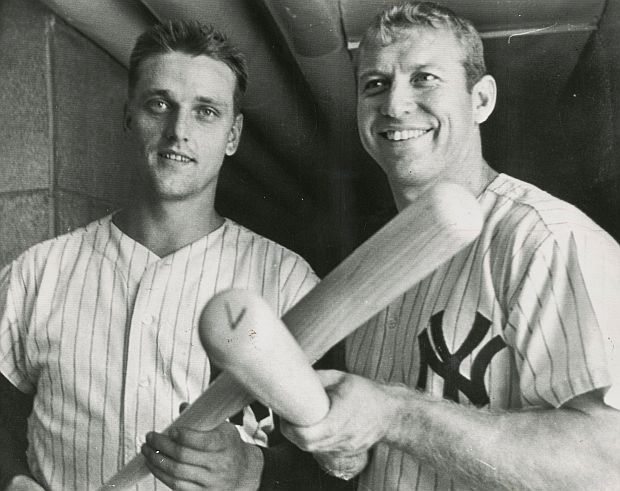
July 3, 1962. The M&M boys had occasional displays of their home run power beyond 1961, as they did here, shown in the locker room after hitting two home runs apiece in a game against the Kansas City Athletics at Yankee Stadium. AP photo,
In 1965 Roger Maris was out with an injury for all but 46 games, though he rebounded somewhat in 1966, playing 119 games hitting 13 homers. Maris, in addition to a painful hand injury (according to one account, he played most of the 1966 season with a misdiagnosed broken bone in his hand) and declining production, had his age-old troubles with the press and Yankee fans who thought him a slacker when he didn’t produce. That December, Maris was traded to the St. Louis Cardinals, becoming a part-time right fielder there, hitting 14 homers with 100 RBI over two seasons. However, in the 1967 World Series, he hit .385 with seven RBIs for the Cardinals in their victory over the Boston Red Sox in seven games. Maris hit his 275th and final regular season home run on September 5, 1968. After 12 years in the major leagues, Roger Maris retired from professional baseball in 1968, having played in 1,473 games with 5,101 at bats. In those years he compiled a .260 batting average with 1,325 hits, 275 home runs, and 851 RBIs.
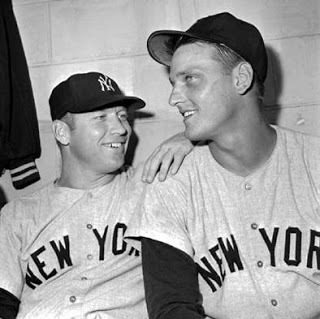
Oct 14, 1964: Mickey Mantle and Roger Maris in locker room following Game 6 of World Series with the St. Louis Cardinals in which they hit back-to-back home runs.
However, the relationship of Roger Maris with the New York Yankee organization and fan base had left some deep scars, and he had vowed never to return again to Yankee Stadium.
Maris had previously turned down repeated Old Timers Day invitations. But over the years, he mellowed a bit, and on opening day 1978, at the urging of new Yankee management, he returned with Mantle to Yankee Stadium for the raising of the team’s championship banner.
As described in The Sporting News book, 61* : “…The scene was electric as Maris, with the tape of his 61 homer playing on the scoreboard, was introduced by the voice of Mel Allen saying, ‘Welcome Back Roger,’ Fans screamed and shouted his name in a tribute that obviously moved the emotional home run champion.”
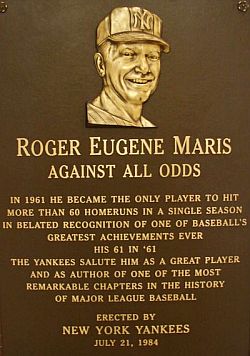
July 1984: Monument Park plaque in honor of Roger Maris's 61 home runs in 1961.
The ceremony was held in Monument Park at Yankee Stadium and also included an inscribed plaque in honor of Maris’s “61 in ’61” home run accomplishment, subtitled “Against All Odds” and praising Maris as “a great player and author of one of the most remarkable chapters in the history of major league baseball.”
Maris by this time, as of November 1983, had been diagnosed with lymphatic cancer. He later died of the disease on December 14, 1985 in a Houston hospital and was buried in his home town of Fargo, North Dakota. He was 51 year old.
Mickey Mantle, meanwhile, following the 1961 season, had his ups and downs both in the field and at the plate. In 1962, he had a good year, batting .321 in 123 games with 30 home runs, 89 RBIs, winning MVP honors. In 1963, he played only 65 games, having sustained a fielding injury on June 5th that year trying to prevent a home run by Brooks Robinson in Baltimore, catching his spikes in the center field chain link fence as he was leaping for the ball, breaking his foot in the process. In 1964, Mantle hit .303 with 35 home runs and 111 RBIs and he also eclipsed Babe Ruth’s career World Series home run record (15) hitting his 16th, and in later years adding two more for a World Series total of 18, which remains the career World Series home run record to this day.
By 1965, the Yankees were not the dynasty Yankees of old, finishing in sixth place. Mantle, meanwhile, was slowed by injuries that year, batting .255 with 19 home runs and 46 RBIs. In 1966, Mantle’s average rose to .288 with 23 home runs and 56 RBI. For the 1967 season, he was moved to first base for less wear and tear on his legs, and on May 14th that year he became the sixth member of the 500 home run club. In 1968, Mantle hit .237 with 18 home runs and 54 RBIs. He announced his retirement on March 1, 1969. When he retired, Mantle was third on the all-time home run list with 536, and he was the Yankees all-time leader in games played with 2,401, until eclipsed by Derek Jeter in 2011. Mickey Mantle was selected to the America League All-Star team in 16 of his 18 years with the Yankees. He entered the Baseball Hall of Fame in 1974, his first year of eligibility. Mantle would die of liver cancer in August 1995 at age 63.
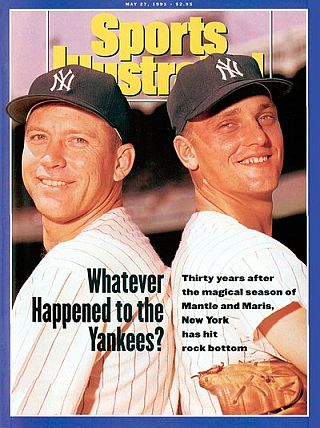
May 1991. Mantle and Maris looking good, 30 years later, as Sports Illustrated pines for Yankees of old. Click for copy.
In Hindsight…
As the years have gone by, the New York Yankees of 1961 have grown in stature, and the performance of Mantle and Maris that year has become a touchstone of dynasty Yankee performance.
By 1991, for example, at the 30th anniversary of Summer of ’61, Sports Illustrated ran a cover story with M&M boys Mantle and Maris pictured, lamenting those glory days gone by, contrasted with the then sinking Yankee performance (last place in 1990).
“Whatever Happened to the Yankees?,” asked the magazine’s cover headline, with the smiling Mantle and Maris looking on. “Thirty years after the magical season of Mantle and Maris,” explained a companion tag line, “New York has hit rock bottom.”
A number of books have also been written chronicling that 1961 season and the home run race, some profiling Mantle and/or Maris, the Yankees that year, the pennant race that season, and more. Some of those titles, with cover photos and links, are listed below in “Sources.” There has also been one film.
Crystal Film
In April 2001, forty years after the home run summer of 1961, came the Hollywood film titled, 61*, a film revisiting the story of Mickey Mantle and Roger Maris as they chased Ruth’s record.

DVD for Billy Crystal film, “61", on the Roger Maris - Mickey Mantle home run race of 1961. Click for DVD.
Crystal had later become a friend to Mickey Mantle and had talked to Mantle about his friendship with Maris and their race for Ruth’s record. The film was written by Hank Steinberg and produced by Robert F. Colesberry. Barry Pepper, who looked a bit like Roger Maris, played Maris, and Thomas Jane appeared as Mickey Mantle. The film follows the real-life Maris/Mantle quest during the 1961 season.
The asterisk in the title reflects the controversy that had raged for time over the Ruth 154-game record vs. the 162 game season that Mantle and Maris played (though no asterisk ever appeared for the Maris home run total).
The film chronicles the negative attention Maris received from fans and the press during the race, and the different lifestyles and personalities of Mantle and Maris during their quest. The film also explores the personal relationship between Maris and Mantle, portraying them as friends more than rivals, with Mantle defending Maris to the New York media, and Maris trying to help Mantle clean up his hard living off the field. The film first aired on HBO on April 28, 2001. Stated Crystal in one interview on what he hoped the film would accomplish: “I wanted it to be an intimate look at these two men and rivals who became friends. Of Mickey being able to say, ’You’re a good man, Roger’… what it was like off the field. I wanted people to come away with a feeling for theses two guys… And to acquaint them with what it was like for Roger to go through this assault on his character…”

April 27, 1962. Roger Maris at the White House, signing a baseball for U.S. President, John F. Kennedy. Click for copy.
Maris & Legacy
Meanwhile, Roger Maris’ single-season home run record of 61 would stand for 37 years, three years longer than Babe Ruth’s previous record. In 1998, Mark McGuire of the St. Louis Cardinals and Sammy Sosa of the Chicago Cubs raced to beat Maris’ record, ending that year, respectively, with 70 and 66 home runs. Barry Bonds set a new record in 2001 with 73 home runs.
However, those numbers by McGuire, Sosa and Bonds, official as they may be, remain contested and tainted since all three players have been suspected for the possible use of performance-enhancing steroids. And so, for many fans, the 61 home runs that Roger Maris hit in 1961, has become the home run milestone now regarded as the untainted record. In 2005, in light of the steroid question, the North Dakota Senate wrote to Major League Baseball to express the opinion that Roger Maris’ 61 home runs should be recognized as the single-season record.
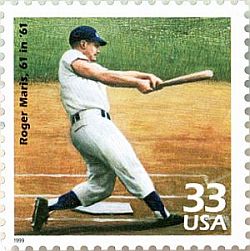
Roger Maris U.S. postage stamp, September 1999.
Still, some fans and sportswriters believe Maris’s absence from the Hall to be a grave injustice, and there is a petition supporting his selection by the Hall of Fame’s Golden Era Committee that considers induction of previously overlooked candidates active between 1947 and 1972. This committee’s next ballot will come in 2020.
In North Dakota, however, Maris has always been regarded as a sports hero. He has been honored with the Roger Maris Museum in Fargo and billboards around town proclaim him as the true home run king. There is also the Roger Maris Cancer Center at Sanford Hospital in Fargo, a beneficiary of an annual golf tournament. In September 1999, the U. S. Postal Service issued a “Roger Maris, 61 in 61” commemorative stamp in his honor.
For additional baseball history at this website please see the “Baseball Stories” topics page, or visit the “Annals of Sport” category page for a broader selection of sports stories. Thanks for visiting — and if you like what you find here, please make a donation to help support the research and writing at this website. Thank you. – Jack Doyle
|
Please Support Thank You |
____________________________________
Date Posted: 21 August 2018
Last Update: 19 September 2022
Comments to: jackdoyle47@gmail.com
Twitter: https://twitter.com/PopHistoryDig
Article Citation:
Jack Doyle, “The M&M Boys: Summer of 1961,”
PopHistoryDig.com, August 21, 2018.
____________________________________
Sources, Links & Additional Information
Ron Smith, Billy Crystal (Foreword), 61*: The Story of Roger Maris, Mickey Mantle and One Magical Summer (Hardcover), 2001, The Sporting News, St. Louis, MO, 160pp.
Maury Allen, Memories of the Mick, Taylor Publishing: Dallas, Texas, 1997.
David Halberstam, October 1964, Villard Books, New York, 1994, 380pp.
“Mickey Mantle, Mini Biography,” Biography .com.
John Drebinger, “Yanks Beat Angels Twice at Stadium; Mantle Clouts Two Homers in Opener…” New York Times, April 21, 1961.
John Drebinger, “Mantle’s 4th Homer in 4 Games Helps Yanks Down Orioles, 4-2…Ford Gains 2d Victory of Week,” New York Times, April 22, 1961
John Drebinger, “Yanks Beat Minnesota in Tenth on Mantle’s Home Run with Bases Filled; 2 Bomber Drives Mark 6-4 Victory; Skowron Homer Sends Game into 10th Inning and Clout by Mantle Beats Twins,” New York Times, May 3, 1961.
John Drebinger, “Yanks Beat Twins Second Time in Row as Maris’ Homer Routs Ramos; Turley’s 6-Hitter Takes 7-3 Verdict…,” New York Times, May 4, 1961.
John Drebinger, “Boyer’s Two-Run Homer in Ninth Enables Yanks to Defeat Angels on Coast; 17,801 Fans See Bombers Win, 5-4; Boyer Bats In Three Runs…Mantle’s Streak Halted,” New York Times, May 6, 1961.
John Drebinger, Yankees Top Athletics With Five-Run Eighth as Mantle Ends Batting Slump; Clevenger Stars in 9-To-4 Victory…,” New York Times, May 11, 1961.
John Drebinger, “Indians Score Five Runs in Eighth-Inning Rally and Triumph Over Yankees; Bombers Bow, 9-7, Despite 3 Homers; Maris, Berra, Lopez Belt Drives but Indians Win With Late Offensive,” New York Times, May 20, 1961.
Robert L. Teague, “Yankees Beat Red Sox on Terry’s 3-Hitter and Kubek’s 9th-Inning Single; Two-Out Safety Decides Game, 3-2… Maris Wallops Homer Only Once in Five Tries…” New York Times, May 25, 1961.
John Drebinger, “Delock Subdues Bombers, 2 to 1; Red Sox Pitcher in Control Except for Seventh, When Mantle Hits a Homer,” New York Times, May 30, 1961.
John Drebinger, “Yanks Belt 7 Home Runs During 17-Hit Attack That Overwhelms Red Sox; Mantle’s Drives Mark 12-3 Game; Maris, Skowron Also Get 2 Homers Each and Berra Clouts One at Boston,” New York Times, May 31, 1961.
Joe King (Boston, MA), “Taped-Up Mick Busts Loose on Home Run Binge; Crippled Mantle Hits Four in Three Games, Leads in Onslaught Against Bosox,” The Sporting News, June 1961.
John Drebinger, “Yanks Beat Red Sox by Halting Rally in 9th; Mantle and Maris Connect; Five Runs in 4th Gain 7-6 Victory; Mantle’s Drive Key Blow — McDevitt, in Relief, Ends Late Red Sox Surge,” New York Times, June 1, 1961.
John Drebinger, “Ford of Yanks Beats White Sox on Two Homers by Berra and One by Maris; Bombers Win, 6-2, Behind Southpaw Ford Pitches a Seven-Hitter Before 38,410, Chicago’s Top Crowd of Season,” New York Times, June 3, 1961.
John Drebinger, “Yanks Rout White Sox in Series Finale as Stafford Pitches Complete Game; Maris Hits No.15 in 10-1 Conquest…,” New York Times, June 5, 1961.
John Drebinger, “Yanks Take Double-Header and Send Twins to 10th, 11th Straight Defeats; Coates, Sheldon Triumph, 6-2, 6-1 Yankees Set League Mark as Blanchard, Mantle and Kubek Wallop Homers,” New York Times, June 6, 1961.
Robert L. Teague, “Home Runs by Mantle and Maris Help Yankees Beat Athletics Before 22,418; Arroyo Is Victor in Relief, 8 to 6; Maris Ends Deadlock with Blast in 7th as Yankees Top Athletics in Rain,” New York Times, June 10, 1961.
John Drebinger, “Ford Wins, 5 to 3; Mantle Clouts Homer and Triple — Yanks Take Series…,” New York Times, June 11, 1961.
John Drebinger, “Yanks, Behind Terry and Sheldon, Take Double-Header From Angels Here; Five Homers Aid in 2-1, 5-1 Sweep; Maris and Berra Belt Two, Mantle One Off Angels…,” New York Times, June 12, 1961.
John Drebinger, “Indians Rout Yanks With Six-Run Outburst Off Coates in First Two Innings; Perry Is Winner in 7-to-2 Contest… Maris Hits 21st Homer for Yanks,” New York Times, June 14, 1961.
John Drebinger, “Homers in Ninth Decide 4-3 Game; Siebern, Covington Connect After Maris Puts Yanks Ahead With No. 25,” New York Times, June 19, 1961.
“Yankees Down Athletics and Gain Second Place as Maris Hits 26th Homer; Stafford Scores Fifth Victory… Maris’ Clout 4th in 4 Games,” New York Times, June 20, 1961.
John Drebinger, “Yankees Down Athletics as Maris’ 27th Homer Paces 5-Run Second Inning; Arroyo Aids Ford in 8-to-3 Victory; Whitey Wins 12th of Season — Maris Drives In 4 Runs With Homer, 2 Doubles,” New York Times, June 23, 1961.
Joseph M. Sheehan, “Yanks Beat Senators as Ford Gains 8th Victory in Row and 14th of Season; Mantle’s Homer Aids 5-1 Triumph; Star Scores on Inside-Park Hit — Maris Drives in 3 Runs — Ford Fans 8,” New York Times, July 1, 1961.
Joseph M. Sheehan, “Mantle Clouts 2; Maris’ Homer in Ninth Wins for Yanks — Arroyo Victor…,” New York Times, July 2, 1961.
Joseph M. Sheehan, “Daley Is Credited with 13-4 Victory; Yank Pitcher Wilts in 9th — Mantle, Howard, Skowron Add Homers to Maris’ 2,” New York Times, July 3, 1961.
Joseph M. Sheehan, “Yanks Divide With Red Sox and Slip to Second as Tigers Beat Angels Twice; Bombers Win, 3-0, Before 9-6 Loss… Maris Hits 33d Homer,” New York Times, July 10, 1961.
Joseph M. Sheehan, “Yanks Beat White Sox and Regain First Place as Maris, Mantle Hit Homers; Stafford Victor in 6-to-2 Triumph… Maris Hits No. 34 — Idle Tigers Drop to 2d,” New York Times, July 14, 1961.
Joseph M. Sheehan, “Pizarro Is Victor with 7-hitter, 6-1; Mantle’s 31st Homer Only Damaging Blow Made Off White Sox Left-Hander,” New York Times, July 15, 1961.
Joseph M. Sheehan, “Maris Hits No. 35; Yanks Win, 9-8, in 10; Keep League Lead — Arroyo Victor Yankees Defeat White Sox, 9 to 8,” New York Times, July 16, 1961.
Joseph M. Sheehan, “Daley Triumphs On 4-Hitter, 2-1; Mantle Bats In Yankee Runs With 32d Homer and a Two-Bagger in Ninth,” New York Times, July 17, 1961.
“Ruth’s Record Can Be Broken Only in 154 Games, Frick Rules,” New York Times, July 18, 1961.
Associated Press, “Houk Roots for His 2 Stars,” New York Times, July 18, 1961.
Joseph M. Sheehan, “Bombers Triumph With 6-Hitter, 5-0; Mantle Connects in Opener — He, Maris Lose Homers When Rain Ends Finale,” New York Times, July 18, 1961.
Joseph M. Sheehan, “2 Mantle Homers Spark 5-3 Victory; Mickey Moves Into Tie With Maris for Clout Honors at 35 as Yanks Win,” New York Times, July 19, 1961.
Joseph M. Sheehan, “Yanks Drop Double-Header to Senators But Cling to American League Lead… 27,126 See Daniels, Donovan Halt Yanks at Washington — Mantle Hits No. 36,” New York Times, July 20, 1961.
Joseph M. Sheehan, “Mantle and Maris Aid 11-8 Triumph; 4 Yanks Hit Homers — Ford Routed in Fifth — Arroyo Victor…,” New York Times, July 22, 1961.
Howard M. Tuckner, “Giants Beat Yanks Before 47,346; Mays’ 2-Run Single, Mantle Home Run Mark 4-1 Game; Coast Club Cheered in First Showing Here Since ’57,” New York Times, July 25, 1961.
Robert L. Teague, “Maris Hits Four Home Runs As Yanks Beat White Sox Twice and Regain Lead; Bombers Defeat Chicago, 5-1, 12-0…,” New York Times, July 26, 1961.
Robert L. Teague, “Blanchard Hits 2 Homers and Mantle Poles No. 39 as Yanks Beat White Sox; Sheldon Is Victor with 4-hitter, 5-2,” New York Times, July 27, 1961.
“Ruth, Gehrig Shared Spotlight In Homer Derby 34 Years Ago,” New York Times, July 27, 1961.
John Drebinger, Sports of the Times, “The Home-Run Whirligig,” New York Times, July 30, 1961.
Walter Bingham, “Assault on the Record: If Either Mantle or Maris Hits 61 Home Runs This Season, Will He Break Ruth’s Record? Herewith a Straight Answer to a Hot Question,” Sports Illustrated, July 31, 1961.
Gordon S. White, Jr., “Mantle’s 40th Homer Highlights Double Victory by Yankees Over Athletics; Arroyo and Terry Triumph… Mantle Ties Maris in Homers,” New York Times, August 3, 1961.
Howard M. Tuckner, “Frick, Giles and Tests of Ball Can’t Explain Homer Increase; Spalding Assures Big League Officials That Specifications of Its Product Haven’t Changed in 25 Years,” New York Times, August 3, 1961.
Robert L. Teague, “Arroyo Triumphs in Relief, 8 TO 5; 24,109 See Yankees Win on Blanchard Hit Off Pleis — Maris Gets 3-Run Homer,” New York Times, August 5, 1961.
Gay Talese, “Fans Want Ruth’s Record Broken; 39 of 50 Here Hope Mantle or Maris Hits 61 Homers,” New York Times, August 11, 1961.
Louis Effrat, “Yankees Rout Senators for Ninth In Row as Mantle and Maris Hit Homers; Terry Is Victor…Mantle Belts His 44th Homer, Maris No. 42,” New York Times, August 12, 1961.
Louis Effrat, “4-Run Homer Wins; Green’s Hit in Seventh Cuts Yank Lead to 3 Games over Tigers; Yankees Are Beaten by Senators in Washington, Despite Maris’ 43d Homer…,” New York Times, August 13, 1961.
Louis Effrat, “Maris Hits 2 Homers and Mantle 1 As Yanks Split Twin Bill With Senators… Maris, Mantle Each Hits No. 45,” New York Times, August 14, 1961.
Robert L. Teague, “Maris Poles Two Homers, for Total of 48, in Yankee Victory Over White Sox; Game Ends at 5-4 as Pitch Hits Cerv; Tie Is Broken in 9th After Maris’ Homers Provide First 4 Yankee Runs,” New York Times, August 17, 1961.
“Math Muscles in On the Race Against Ruth – The Odds on Mantle and/or Maris Breaking Babe Ruth’s Home Run Record,” Life, August 18, 1961, pp. 62-70.
John Drebinger, “Yankees Bow to Indians Before 37,840 Fans as Mantle and Maris Go Hitless…,” New York Times, August 19, 1961.
William Barry Furlong, “That Sixtieth Home Run; Baseball’s Big Guns Are Still Trying to Top a Record Set in 1927,” New York Times Magazine, Sunday, August 20, 1961.
John Drebinger, “Arroyo Relieves; Howard’s Hit Wins – Maris and Mantle Fail to Connect; ..Ford Wins No. 21…,” New York Times, August 19, 1961.
UPI, “Home-Run Odds Quoted; Bookie Offers 5 to 6 Either Way on Maris or Mantle,” New York Times, August 20, 1961.
John Drebinger, “Yankees Turn Back Indians Twice as Maris Hits No. 49 and Mantle No. 46… Mantle Drives in 6 Runs — Skowron Connects,” New York Times, August 21, 1961.
“Yanks’ Homer Derby Goes West And Berra Ponders a New Pitch; Yogi Asks: What Happens if One Star Hits 61 in 154 Games but the Other Finishes With More in 162?,” New York Times, August 22, 1961.
John Drebinger, “Maris Clouts 50th Homer But Yankees Lose to Angels in Contest on Coast…,” New York Times, August 23, 1961.
Arthur Daley, “Sports of The Times; One Who Came Close (Greenburg), New York Times, August 27, 1961.
John Drebinger, “Maris’ 51st Helps Yanks Win… A’s Beaten, 5 to 1; Yanks Raise Lead to 2 1/2 Games…,” New York Times, August 27, 1961.
John Drebinger, “Sheldon, Arroyo Aid 8-7 Triumph… — Maris, Mantle Hitless — Howard, Berra Clout Home Runs,” New York Times, August 28, 1961.
John Drebinger, “Mantle on Homers: The Players Are Livelier; Yankees’ Star Says Maris Should Get Credit for Feats; Pitchers Are Called Slicker, Smarter Than in Past,” New York Times, August 29, 1961.
Robert L. Teague, “Casey the Computer Says Maris Will Set Mark; But Electronic Brain Thinks Mantle Has Little Chance,” New York Times, August 30, 1961.
John Drebinger, “Crowd of 40,118 Sees 3-0 Contest; Record Bloomington Turnout Watches Pascual of Twins Fan Mantle 3 Times,” New York Times, August 30, 1961.
John Drebinger, “Twins Beat Yanks Despite Mantle’s 48th Homer;…Sheldon Routed in 5-to-4 Defeat; Yank Lead Cut to 1 1/2 Games — Season Homer Mark of 195 Set — Maris Halted,” New York Times, September 1, 1961.
Gay Talese, “Mantle, Maris and a Few Others Stir a Potpourri of Fan Emotion,” New York Times, September 2, 1961.
John Drebinger, “Lead Is 3 1/2 Games; 50,261 See Yanks Win…as Maris Hits 52d and 53d Homers…Colavito of Tigers Hits No. 40,” New York Times, September 3, 1961.
John Drebinger, “Mantle Makes It 49 and 50 and Yanks Make It Three Straight Over Tigers; Howard’s Homer Caps 8-5 Victory; Drive in 9th Defeats Tigers After Mantle Ties Score — 55,676 See Game,” New York Times, September 4, 1961.
John Drebinger, “Yanks Sink Senators Twice; Mantle Plays One Inning and Maris Goes Hitless; …Yanks Take First on Homer by Blanchard…,” New York Times, September 5, 1961.
Robert L. Teague, “Maris’ 54th Homer, One of 5 by Yanks, Marks Ford’s Shutout Over Senators; Bomber Ace Gains 23d Triumph…Blanchard Hits 2 Homers…,” New York Times, September 7, 1961.
Robert L. Teague, “Maris Hits 55th Homer as Yankees Beat Indians and Lift Lead to 9 Games…Mantle’s Double Snaps Tie in 6th,” New York Times, September 8, 1961.
Robert L. Teague, “Mantle Hits Homer No. 52 as Yanks Down Indians Before 41,762 at Stadium; Bombers Capture Ninth in Row, 9-1 Stafford Hurls 7-Hitter and Belts Triple and Single — Kubek Clouts Homer,” New York Times, September 9, 1961.
UPI, “[Ted] Williams ‘Pretty Sure’ Maris Will Set Record,” New York Times, September 10, 1961.
John Drebinger, “Maris Hits No. 56 As Yanks Beat Indians; 4 Runs in 9th Win; Yankees Take 10th in Row — Arroyo Victor — Mantle Stopped…,” New York Times, September 10, 1961.
Robert L. Teague, “The Not-So-Private Life of the M-Squad; Home Runs on Field and Home Fun Just Do Not Mix; Mantle Likes Films and Golf — Maris Reads Sports; Yankee Sluggers Short on Privacy,” New York Times, September 10, 1961.
John Drebinger, “Mantle Hits No. 53 as Yanks Extend Streak to 12 by Beating Indians Twice; Maris Is Stopped …57,824 See Yank Sweep…,” New York Times, September 11, 1961.
Louis Effrat, “Hank Greenberg Roots for Mark In Homers by Maris or Mantle,” New York Times, September 14, 1961.
John Drebinger, “White Sox Turn Back Yanks Twice; Maris and Mantle Fail to Hit Homers…Winning Streak Ends at 13 — Maris Gets Three Singles — Mantle Hitless,” New York Times, September 15, 1961.
Louis Effrat, “Mantle Concedes He Can’t Beat Ruth Homer Mark in 162 Games,” New York Times, September 15, 1961.
Louis Effrat, “Maris Sulks in Trainer’s Room As Futile Night Changes Mood,” New York Times, September 16, 1961.
John Drebinger, “…Four Yank Hurlers Allow 17 Hits Yanks Lose, 10-4; Maris Hits No. 57,” New York Times, September 17, 1961.
Louis Effrat, “Maris’ Big Bat Speaks Louder Than He Does; 57th Homer Gets Ace Talking Again, But Not Effusively, Abusive Crowd, ‘Bad Press’ Embitter Yank Slugger; Maris Still Lets Bat Talk for Him,” New York Times, September 17, 1961.
“Computer Says It’s 20-1 Maris Won’t Set Mark,” New York Times, September 17, 1961.
John Drebinger, “Maris’ 58th Homer Gives Yanks Victory Over Tigers in 12th Before 44,219; Two-run Wallop Decides 6-4 Game…, ” New York Times, September 18, 1961.
Louis Effrat, “Maris, Second Only to Ruth Now, Stirred by the Thrill of the Chase,” New York Times, September 18, 1961.
John Drebinger, “Yanks Win Pennant… Maris Hits 59th Homer But Misses 154-Game Mark; Bombers Victors At Baltimore… Maris Connects But Fails to Tie Ruth Mark of 60,” New York Times, September 21, 1961.
John Drebinger, “Yanks 8-3 Victors; Ford Stops Red Sox for 25th Triumph… Mantle Hits 54th…” New York Times, September 24, 1961.
Philip Shabecoff, “Maris Likely to Top $100,000 For Earnings Outside Baseball,” New York Times, September 24, 1961.
John Drebinger, “Maris Hits No. 60 as Yankees Win; Wallop Starts Team To a 3-2 Victory Over Orioles,” New York Times, September 27, 1961.
John Drebinger, “Mantle Is Hospitalized, But Yankees Expect Him to Play in World Series; Mickey Will Miss 3 Red Sox Games; Abscessed Hip Sends Mantle to Hospital — Maris Hopes for 61st Homer Tonight,” New York Times, September 29, 1961.
John Drebinger, “Maris Hitless as Yankees Beat Red Sox; Mantle to Leave Hospital Sunday; Blanchard Drive Decides, 2-1…,” New York Times, September 30, 1961.
Roger Kahn, “Pursuit of No. 60: The Ordeal of Roger Maris,” Sports Illustrated, October 2, 1961.
John Drebinger, “Maris Hits 61st in Final Game; Yank First to Exceed 60 Home Runs in Major Leagues;…Right-Field Shot Wins 1-To-0 Game; Maris Is First to Go Above 60 Homers – 4th-Inning Drive Caught by Youth,” New York Times, October 2, 1961, p. 1.
Louis Effrat, “Mantle to Stay Out of World Series Opener Unless His Condition Improves; Yankee Slugger Weak and in Pain; Club Doctor Says He Thinks Mantle Can Play, However…,” New York Times, October 3, 1961.
Arthur Daley, “Sports of The Times; The Homer Epidemic,” New York Times, October 3, 1961.
Joseph Durso, Obituary, “Roger Maris is Dead at 51, Set Record Home Runs,” New York Times, December 15, 1985.
Alan Schwarz, Word for Word/Sports Journalism, “1961-62; One for The Records: How The Press Hounded Roger Maris,” New York Times, August 30, 1998.
Kevin Kernan, “No. 18: M&M Boys Chase The Babe: Summer of ‘61,” New York Post, September 26, 1999.
Allen Barra, “Roger Maris’s Misunderstood Quest to Break the Home Run Record; 1961 Was One of Baseball’s Most Exciting Seasons—But it Also Gave Rise to a String of Persistent Myths,” TheAtlantic.com, July 27, 2011.
Bill Pruden, “Roger Maris,” Society for American Baseball Research.
“Mickey Mantle Stats,” Baseball-Almanac .com.
James Lincoln Ray, “Mickey Mantle,” Society for American Baseball Research.
“Roger Maris,” Wikipedia.org.
Mickey Mantle,” Wikipedia.org.
Nick Acocella, “Maris Battled Mantle, Media, and Babe’s Legacy,” ESPN.com.
Michael K. Bohn, McClatchy-Tribune News Service, “Fifty Years Ago, Roger Maris and Mickey Mantle Produced Great Home Run Derby, Debate,” Morning Call (Allentown, PA), September 28, 2011.
Jane Leavy, “The Last Boy: An Excerpt From Jane Leavy’s Acclaimed Mickey Mantle Biography,” GrantLand.com, October 10, 2011.
“The Last Boy,” JaneLeavy.com.
Harold Friend, “Maris and Mantle: Back-to-Back and Wall-to-Wall Home Runs at Yankee Stadium,” BleacherReport.com, May 12, 2012.
_______________________________
